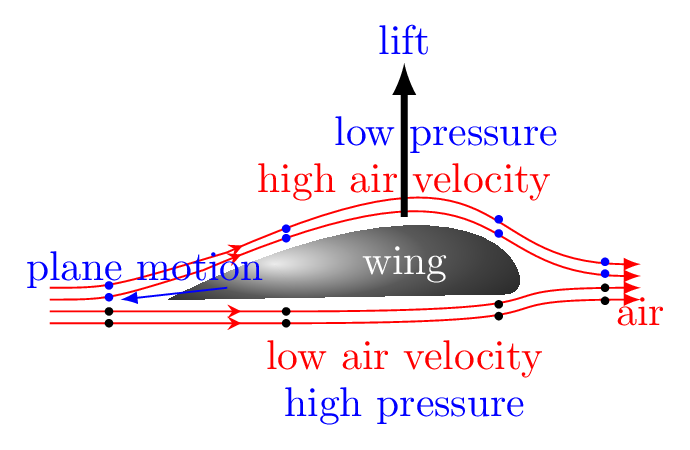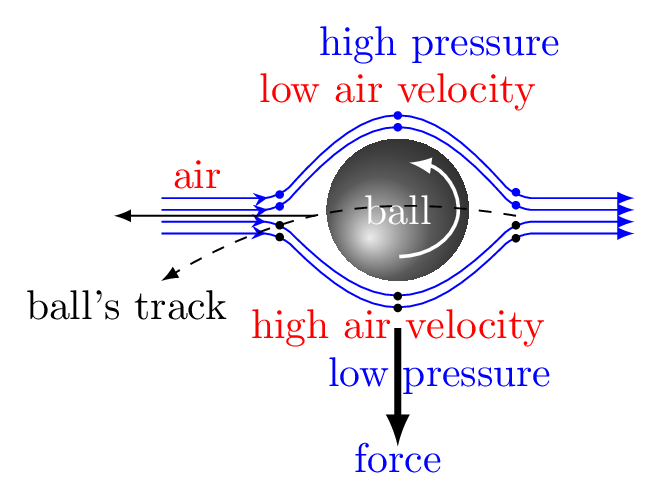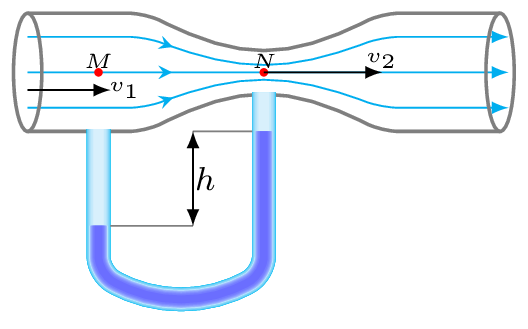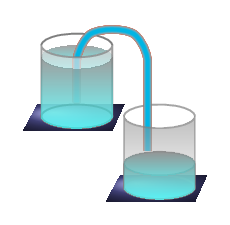Subsection 9.2.3 Applications of Bernoulli’s Principle:
-
Airplane Wing.The top of the airplane wing is curved, while the bottom of the wing is totally flat. When an airplane runs air travels across the top of the wing is faster then it travels below the bottom part of the wing so that the air molecules travel equal distance in equal time (equal transit theory) to catch each other at the end of the wing. This phenomenon creates high pressure at the bottom and less pressure at the top. This pressure difference creates lift and allows planes to fly or take off easily [Figure 9.2.3].

Figure 9.2.3. -
Spinning Ball.The ball spins in such a way that it decreases the velocity of air at top and increases the the velocity of air on the bottom. Which allows more air pressure on the top of the ball and less air pressure at the bottom of the ball. Due to which the ball accelerates downwards faster than the top part and the ball curves downward, which causes the batter to miscalculate the ball’s position [Figure 9.2.4].

Figure 9.2.4. -
Venturi Meter.It is a device used to measure the speed of the fluid. It is a broad tube with constriction at the middle as shown in Figure 9.2.5. A manometer of U-shape is attached to it with one arm at the broad side and the other at the constriction. When the speed of incompressible fluid increases at the constriction, it lowers the pressure at that point. The pressure difference causes the manometer fluid (water) in the tube to rise in one arm and depressed at the other arm. The difference in height, \(h\) measures the pressure difference. From Bernoulli’s principle

Figure 9.2.5. \begin{equation*} p_{1}+\frac{1}{2}\rho v_{1}^{2}+\rho g h_{1} =p_{2}+\frac{1}{2}\rho v_{2}^{2}+\rho g h_{2} \end{equation*}\begin{equation*} p_{1}-p_{2} = \frac{1}{2}\rho v_{2}^{2}-\frac{1}{2}\rho v_{1}^{2} \end{equation*}Since the horizontal axis of the venturi meter is passing through the points M and N is at same height. Therefore \(\rho g h_{1} = \rho g h_{2}.\)\begin{equation} \text{or,}\quad p_{1}-p_{2} = \frac{1}{2}\rho \left(v_{2}^{2}- v_{1}^{2}\right) \tag{9.2.2} \end{equation}From equation of continuity,\begin{equation*} A_{1}v_{1} = A_{2}v_{2} \end{equation*}\begin{equation} \therefore \quad v_{2} =\frac{A_{1}v_{1}}{A_{2}} \tag{9.2.3} \end{equation}where \(A_{1}\) and \(A_{2}\) are area of cross-section of the venturi tube at wide section and at the constriction.\begin{equation*} \therefore \quad p_{1}-p_{2} = \frac{1}{2}\rho \left[\left(\frac{A_{1}v_{1}}{A_{2}}\right)^{2}- v_{1}^{2}\right] \end{equation*}\begin{equation} = \frac{1}{2}\rho v_{1}^{2} \left[\left(\frac{A_{1}}{A_{2}}\right)^{2}- 1 \right] \tag{9.2.4} \end{equation}The pressure difference between points M and N is also the pressure difference between the manaometer fluid at two points. That is the top of the water column on the left-hand side of the U-tube and the water column on the right-hand side. Hence,\begin{equation*} p_{1}-p_{2} = h\rho_{w}g \end{equation*}where \(h\rho_{w}g \) is a gauge pressure in manometer.\begin{equation} \therefore \quad h\rho_{w}g = \frac{1}{2}\rho v_{1}^{2} \left[\left(\frac{A_{1}}{A_{2}}\right)^{2}- 1 \right] \tag{9.2.5} \end{equation}This equation will help find the speed of fluid (gas or liquid) entering into the venturi tube. -
Siphon Effect.when one end of a pipe is deep into liquid and suck the air out from another end then there is vacuum created in the pipe and pressure gets low with respect to the atmospheric pressure at the surface of reservoir. This reduced pressure sucks the liquid up against the gravity and hence once the liquid rises up to the top of the pipe and due to gravity it begins flowing to the lower end of the siphon pipe to exit [Figure 9.2.6].

Figure 9.2.6.
There are numerous applications of Bernoulli’s principle found in our daily life, e.g., spray atomizer, throwing of frisbees, flying of kites, Bird’s wing design, water pump, etc.
